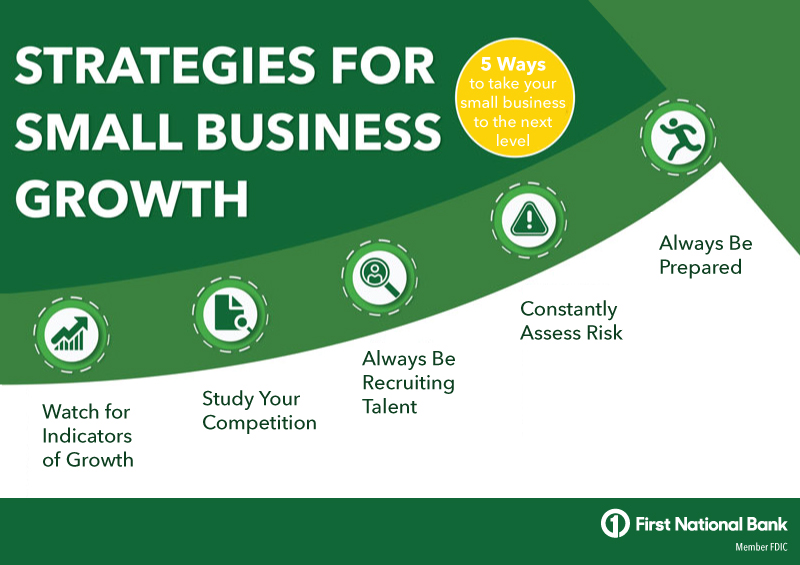FDIC-Insured - Backed by the full faith and credit of the U.S. Government
-
-

-
Clint Sporhase
Vice President, Business BankingOctober 01, 2018
-

Strategies for Small Business Growth
If you are ready to take your business to the next level it is helpful to put a strategic plan in place. Here are some strategies that can help break through some of the common barriers to growth that many small businesses experience.
Watch for Indicators of Growth
Before you embark on any growth strategy, step back and take a look for some key business indicators to help you decide whether you are actually ready for growth. Are you successful in a current market and want to open a new location? Are you about to clinch a big sales deal? Is your sales pipeline full? Is product development success opening the door to new opportunities? These are all important indicators that will drive growth and should be constantly monitored to ensure you are able to effectively prepare for that growth. Study your pipeline, conversion rates, and market trends in dashboard form every day.
Study Your Competition
At the basis of any growth strategy should be a deep knowledge of where you stand against your competition. A quarterly SWOT (Strengths, Weaknesses, Opportunities, and Threats) analysis can help you determine how you compare to your competitors and identify areas of opportunity to exploit your strengths and their weaknesses. Likewise, it will give you a good view of any threats to your growth and help you develop a plan to fix or compensate for them. Next, you should conduct a market analysis to find out how your customers view your business. You will also want to identify customers view your competition and what factors would make them buy from them instead of you. Look for ways to differentiate your business. How does your competition position itself in the marketplace relative to your business? How does your business/product/service contrast with theirs? Why would a customer buy from you and not them? The answers to these questions will help you see your strengths, exploit market opportunities, and execute a tactical plan to get ahead.
Always Be Recruiting Talent
Setting the stage for growth must involve superstar employees. Even if you can’t afford to hire them full-time, always keep an eye out for good talent and hire them on part-time, contract, or hourly basis. Then, when you are ready to grow, you already have the quality staff to support your goals.
Constantly Assess Risk
As a business owner you must always anticipate and manage risk. Look ahead and try to predict variables that could occur that might compromise or damage your growth plans. These could be supply chain issues, hiring and training problems, competitive activity, cash flow, or patent infringements. Include these in your SWOT analysis and develop a plan to prevent or manage any issues.
Always Be Prepared
The bottom line is you must always have a plan when trying to grow your business. Never embark on a growth strategy without one. Your plan should contain the key elements discussed above. Break your plan down into chunks – have one strategic plan that contains your market findings and helps inform where you are and where you want to be. Then assemble smaller plans. For example, have a day-to-day operations plan, a hiring plan, and a marketing plan, each of which lay out the tactics for using your business resources to accomplish your strategy.
If you need help creating a business plan, check out SBA’s Build Your Business Plan Tool. This step-by-step online tool guides you through the process of creating an actionable plan.
The articles in this blog are for informational purposes only and not intended to provide specific advice or recommendations. When making decisions about your financial situation, consult a financial professional for advice. Articles are not regularly updated, and information may become outdated.
